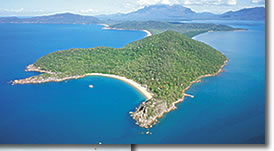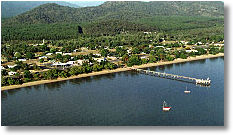Off the North Queensland tropical coast of Australia, between Ingham and Tully, lies 15 continental islands, ranging from the 39,300ha Hinchinbrook Island to tiny Tween Island.
They present a landscape spectacle of sandy beaches, precipitous headlands, waterfalls, rugged mountains, mangrove forests, coral reefs, sheltered bays and dense rainforests. Surrounding the tropical islands are the waters of the Great Barrier Reef Marine Park, the largest coral reef system in the world.
Hinchinbrook Island is one of the world’s most diversely beautiful wilderness areas.
This 39.3 sq. km island lying off the Cardwell coast, halfway between Cairns and Townsville in North Queensland Australia, is Australia’s largest island National Park. The island has a rich aboriginal history and was first seen by Europeans in 1770 when Captain Cook sailed past. Its rugged skyline is dominated by 1121m Mt. Bowen which towers over a rainforest wilderness, mangrove-lined shores and spectacular golden sandy ocean beaches.
 The island has been separated from the mainland by the deep, narrow mangrove fringed Hinchinbrook Channel for approximately 100,000 years and has remained in relatively uninhabited, pristine condition.
The island has been separated from the mainland by the deep, narrow mangrove fringed Hinchinbrook Channel for approximately 100,000 years and has remained in relatively uninhabited, pristine condition.
It is this unique pristine condition that has caused the Australian Government to select this island as an area for special protection. Only small sample areas of the island have been opened for visitor access for very limited numbers.
A secluded Wilderness Lodge at Cape Richards is the island’s only settlement. This eco-Lodge offers ‘splendid isolation’ in spacious crafted timber ‘treehouses’ that are accessed by a meandering timber boardwalk .The Wilderness Lodge makes a great base from which to explore the many activities on offer on the island, such as bushwalking, fishing, snorkelling, swimming, day cruises, birdwatching or just laying around and soaking it all in. For more information about the Wilderness Lodge CLICK HERE.
Whether its for a day visit or a weeks trekking, visitors to Hinchinbrook can choose from hiking through the majestic and unspoiled rainforest, relaxing on one of the secluded golden sand beaches or merely capturing the islands splendour from the comfort of a vessel whilst cruising through the magnificent Hinchinbrook Channel.
While visitor access to the islands is very limited in terms of numbers allowed per day, the process of visiting is very simple and affordable.
 Cardwell, a small seaside holiday town, lies on the main National Highway between Cairns in the north and Townsville in the south. It is serviced by regular buses and trains and has shops, motels, caravan parks, backpacker hostels and a post office.
Cardwell, a small seaside holiday town, lies on the main National Highway between Cairns in the north and Townsville in the south. It is serviced by regular buses and trains and has shops, motels, caravan parks, backpacker hostels and a post office.
Accommodation in Cardwell
For more information about local caravan parks, B&B, resort, motel and backpacker hostel style, visit this selection of websites listed below and we are sure you will find something that will suit your requirements.
Beachcomber Motel – in town with restaurant
Cardwell Bed & Breakfast – in town
Hinchinbrook Island Wilderness Lodge – on Hinchinbrook Island
Inspiration Resort – Port Hinchinbrook
Kookaburra Holiday Park – central caravan park
Mudbrick Manor – out of town B & B
Port Hinchinbrook – resort
Ripples Holiday Apartments – Port Hinchinbrook
Climate
The climate is humid tropical, with an average January (mid summer) temperature of 32 degrees Celsius and an average July (mid winter) minimum of 13 degrees.
The gentle collision of moisture laden onshore breezes with the mountainous peaks of Hinchinbrook Island and the Cardwell Range produces an average annual rainfall of 2143 mm at Cardwell, most falling in Summer. Although no record is made, parts of Hinchinbrook receive more than 3500mm a year. Most occurs in heavy downpours between December and April.
For more thorough information on the Climate Averages for Cardwell go to the respective Bureau of Meteorology page CLICK HERE.